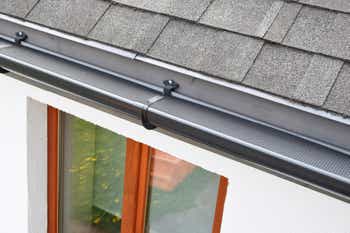Gutter guards are unsung heroes in preventing fire and water damage since they help reduce debris from clogging up your gutter system. If you haven’t installed gutter guards yet, make a plan this weekend to get the job done. After all, it’s a simple way to protect your home! In this blog, we'll review what gutter guards are, the available types, and how to install them.
What Are Gutter Guards?
Gutter guards are shields that go over your gutters to help reduce debris — e.g., leaves, pine needles, etc. — from building up inside the gutters. Without gutter guards, clogging happens, which obstructs rainwater flow. While gutter guards help minimize debris buildup, they don’t completely eliminate the need to clean your gutters, but they make the job easier and less frequent.
Types of Gutter Guards
Several types of gutter guards are on the market, each with pros and cons. Some popular types include:
- Screen: Screen gutter guards sit on top of your gutters and have holes that allow water to pass through while keeping large debris out. They’re affordable DIY gutter guards, but small debris, such as seeds, can pass through the holes and end up in your gutter. Also, you’ll need to remove and clean them at least once a year.
- Micro-mesh: Micro-mesh gutter guards are screen guards with nearly microscopic holes, helping block out most debris. They’re durable, effective, and easy to clean but often require professional installation.
- Reverse-curve: Reverse-curve gutter guards — or surface-tension guards — start beneath the shingles, extend over the gutter, and curve back slightly. These gutter guards typically require professional installation, but they’re long-lasting and require little maintenance once in place.
- Brush: Brush gutter guards resemble giant pipers with stiff brushes. They sit inside your gutters with the bristles pointed up to block large debris. They’re easy to install, but small debris, such as pine needles, can get caught in the bristles, making them a hassle to clean and remove.
- Foam: A foam gutter guard is a piece of foam inside your gutter. It’s affordable, easy to install, and effective at capturing large debris, but debris may enter through the gaps between the foams and gutter walls or build up on top of the foam, hindering water flow. Additionally, you’ll need to replace them every year or two.
How to Choose the Right Gutter Guards
Choosing the right guards depends on price, installation, and performance. If you’re going down the DIY route, foam, brush, and screen gutter guards are suitable options. Some micro-mesh brands offer DIY installation, while others require professional installation. On the other hand, most reverse-curve gutter guards require professional installation.
Screen gutters may be the best option if you're seeking a good balance between affordability, DIY installation, and effectiveness. However, if you don’t mind paying more for your gutter guards while still having the option to install them yourself, micro-mesh guards might be a good choice for you.
DIY vs. Professional Gutter Guard Installation
DIY gutter guard installation helps significantly reduce your expenses by cutting out the parts and labor from a professional installation. Most home improvement stores offer DIY gutter guard kits, so all you’ll need is a ladder and a few basic tools.
You can also hire a professional to install gutter guards on your existing gutters or as part of a new gutter system. While this route is more expensive than doing it yourself, professional gutter guard installation provides convenience, improved performance, and peace of mind knowing your guards are installed correctly. Additionally, professional installation can help ensure your safety, especially if your roof is particularly high or steep.
How to Install Gutter Guards
Want to install gutter guards by yourself? The exact instructions for installing gutter guards depend on your specific product. However, there are some basic preparation and installation steps you can follow.
Preparation
Taking time to do some prep work can help forge a smoother installation:
- Measure your gutters: Certain gutter guards are made to size. Measure your gutters beforehand to ensure your guards aren’t too wide or narrow.
- Clean and test your gutters: Clean your gutters and test the water flow. If there are any leaks, address them before installing gutter guards.
- Read the instructions: Once you decide which gutter guards to get, read the instructions thoroughly. Also, research video tutorials or read customer reviews to ensure you avoid common mistakes.
- Get necessary tools and supplies: Check the instructions for the required tools. You’ll certainly need a ladder, but you may also need a screwdriver, power drill, hammer, clamps, and other equipment.
Installation
Once you’ve completed all the prep work, you’re ready for installation. Here are some general guidelines to follow depending on the type of gutter guards you get.
Brush or Foam
These gutter guards are incredibly easy to install. You just place them end-to-end inside your gutters and trim them so they match your gutter’s length.
Screen or Micro-Mesh
- Step 1: Clip the screen’s lip to the front of the gutter.
- Step 2: Slide the backside of the screen under your roof’s shingles.
- Step 3: Repeat the process until the gutter is covered from end to end. (NOTE: Overlap mesh sections by at least half an inch.)
Again, these are just general guidelines. Read the instructions on your specific product and check the manufacturer's website for tips and tricks.
What Are the Benefits of Installing Gutter Guards?
Gutter guards are vital in keeping your home safe from a wildfire because they catch debris, including leaves and pine needles, that can easily ignite and spread fire to your roof. They also help manage rainfall by directing the water away from your home’s structure and preventing water damage. Plus, taking the time to install them saves you the hassle of not having to clean the debris out of your gutters as often.
Conclusion
Installing gutter guards is a great way to reduce maintenance and safeguard your home from potential water or wildfire damage. However, this is just one step in protecting your home. To ensure your family and home are protected, get homeowners insurance from Mercury, where we provide best-in-class coverage at an affordable rate.
Contact us today for a fast, free quote!
FAQs About Installing Gutter Guards
When is the ideal time to install gutter guards?
Late summer or early fall is a great time to install gutter guards because it helps your home prepare for the heavy volume of leaves and other debris that can make their way into your gutters.
How long does it take to install gutter guards?
It depends. Prep time, your home’s size, the complexity of your roof edges, and the type of gutter guards you get all influence the installation’s time length. Generally, you can expect the project to take anywhere from a couple of hours to a couple of days.


